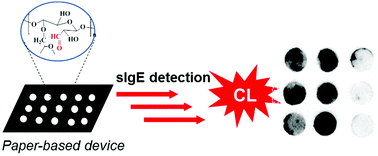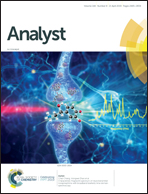A paper-based chemiluminescence immunoassay device for rapid and high-throughput detection of allergen-specific IgE†
Abstract
The fast and precise detection of potential allergen-specific immunoglobulin E (sIgE) is imperative for the diagnosis and appropriate treatment of allergic diseases. In this study, we have successfully fabricated a novel paper-based immunoassay device for the detection of sIgE in allergic diseases. We used Can f 1, one of the main dog allergens, as a model allergen to detect sIgE in human sera. To achieve excellent performance, the experimental parameters were optimized. Further, we extended this device for potential applications in the clinical diagnosis of allergic diseases: worthwhile clinical performance in the detection of allergens was achieved as compared to that achieved by commercial enzyme-linked immunosorbent assay (ELISA) kit. Therefore, it was proven that this strategy has the advantages of high-throughput, rapid, sensitive, and highly accurate detection of trace amounts of sIgEs. Furthermore, by simply changing the antigen and antibody, this device could be used for the high-throughput detection of other allergens, so as to achieve multiallergen detection and appropriate desensitization therapy, thereby making it promising in the determination of allergic diseases in clinics.



 Please wait while we load your content...
Please wait while we load your content...